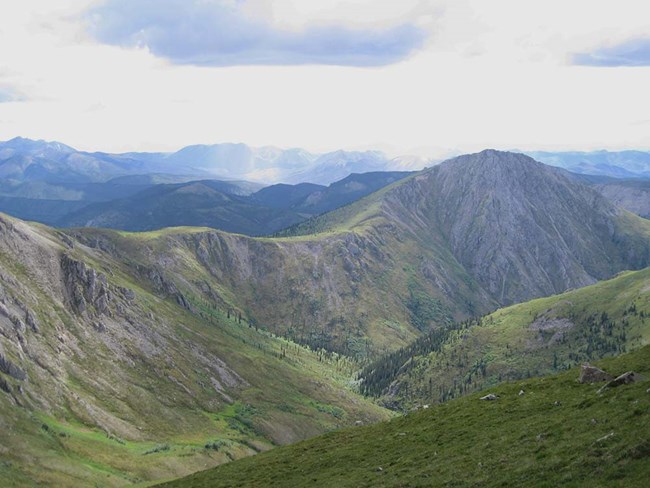Last updated: May 18, 2021
Article
Borealization and its Discontents
Drivers of regional variation in plant diversity across scales in interior Alaska

Understanding the driving forces behind biodiversity is critical to understanding our rapidly changing environment, but the sheer scope of ecological shifts and the many variables involved can make identifying those forces a challenge. This new study, along with its companion study published last year in Ecological Monographs, uses comprehensive, landscape-scale vegetation monitoring to uncover some of the factors that drive plant diversity in northern and central Alaska. It’s the first study of its kind in a high-latitude region that is subject to an accelerated rate of climate change.
NPS researchers sampled from two extensive study areas: one in Denali National Park and Preserve at the foot of the Alaska Range and another in Yukon-Charley Rivers National Preserve near the U.S.-Canada border. Both areas are characterized by a wide range of elevations and vegetation types, but also have some significant differences. The Denali area is cooler and wetter in the summer with less fire disturbance, while the Yukon-Charley area is warmer, drier, and more fire-prone. The Denali area was covered by glaciers more recently than the Yukon-Charley area, leading to a different geology and evolutionary history. The two regions offer a “natural experiment” to study how different environmental factors affected vegetative diversity, or “richness.”
Researchers sampled from a series of evenly spaced plots laid out in a grid pattern, recording every species they observed in each plot, for 924 plots in Denali and 733 in Yukon-Charley. They also recorded a suite of other environmental data for each of the plots including elevation, slope and soil pH.
The overall composition of plant species between the two areas turned out to be broadly similar and, at smaller scales, the relationships between richness and environmental factors were the same as well. There tended to be more plant species at higher elevations, as less diverse boreal forest gave way to more open habitat that supported a wider array of smaller plants. High-altitude richness tended to be more pronounced in Denali, while plant communities dominated by woody species tended to extend into higher elevations in the warmer, drier Yukon-Charley area.In addition to revealing these patterns of biodiversity, the study also established a strong network of monitoring plots in some of Alaska’s wildest, most remote areas. Scientists can use these plots in the future to answer more specific questions about plant diversity in the region and monitor ecological changes over time.
Borealization and its discontents: Drivers of regional variation in plant diversity across scales in interior Alaska
Abstract
Quantitative studies of regional variation in plant diversity across eastern Beringia (northern Alaska and adjacent areas) are lacking due to an absence of datasets of sufficient scale and scope. We interrogated a landscape‐scale plant diversity dataset collected across two regions of interior Alaska with different disturbance, topographic, and climate attributes to investigate hypotheses regarding drivers of plant species richness. Our approach integrated a multi‐scale sampling design with an analytical framework focused on quantifying how components of plant diversity (growth forms, biogeographic groups, and dominant species) respond to site factors that vary along landscape gradients. Our results revealed essential similarities in both the composition of the overall floras and the influences on local and meso‐scale species richness across both regions. However, these continuities at smaller scales contrasted with differences in landscape‐level distribution of plant diversity patterns along elevation gradients. Our findings suggest that local drivers of richness and occupancy interacted with differing macro‐scale attributes (e.g., relative continentality) to produce distinctive landscape‐level diversity patterns. Our results confirm that high levels of local and meso‐scale plant richness in interior Alaska depend on conditions that foster richness of herbaceous and northerly distributed species groups. However, we found that important differences in landscape‐level richness patterns were driven by regional differences in climate, topoedaphic variables, and disturbance. In the warmer region, woody species and boreal plant communities extended to higher elevations and common species occupancy showed marginally greater influence of fire. Overall richness was relatively low in alpine areas of the warmer region but heterogeneous edaphic and topographic circumstances stimulated higher species turnover in lower elevations there, increasing landscape‐level richness. In contrast, in the cooler region, woody species showed restricted distribution across the elevation gradient while site attributes associated with increased species richness aligned with the elevation gradient and thus peak richness occurred in the alpine zone. Our results show how total and growth‐form richness, as well as community composition, vary regionally in relation to important drivers (including growing season warmth) across interior Alaska. Consequently, our study provides new insights into the potential trajectories of future change in biodiversity patterns in this rapidly warming region.
Roland, C., J. H. Schmidt, S. E. Stehn, C. J. Hampton-Miller, and E. F. Nicklen. 2021. Borealization and its discontents: Drivers of regional variation in plant diversity across scales in interior Alaska. Ecosphere 12(5): e03485.
